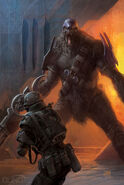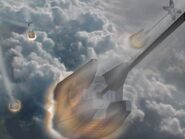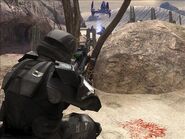| This fanfiction article, Orbital Drop Shock Troopers (Necros), was written by Spartan-091 and Ajax 013. Please do not edit this fiction without the writers' permission. |
| |||||||||||||||||||||||
| [Source] | |||||||||||||||||||||||
- "We go feet first, sir!"
- ―Shock Troops to Major Antonio Silva, aboard the UNSC Pillar of Autumn.
The Orbital Drop Shock Troopers (more commonly referred to as "ODST") are an elite group of UNSC Marines that specialize in shock warfare tactics. Their method of infiltration by orbital insertion allows them to conduct missions against targets that other conventional forces cannot approach while remaining undetected.
The ODSTs are one of the primary Special Operations units of the UNSC, and are under the direct command of UNSC Special Operations Command.
History[]
The Concept of Shock Infantry[]
Shock troops consist of infantry formations and their supporting units, and are intended to spearhead an attack into enemy territory. "Shock Troop" is a loose translation of the German word "Sturmtrupp," or "storm soldier." Assault or Shock units are typically organized for mobility and high firepower, with the intention in mind that they will penetrate through the enemy's defenses and drive into the enemy's vulnerable rear areas or relatively-unprotected flanks.
Although the term "Shock Troops" became popular in the 20th century, the term is rarely used explicitly, as the strategic concepts behind it have become standardized in contemporary military thinking.
Origins[]
The idea of inserting highly trained troops behind enemy lines from high altitude atmosphere has its roots in the paratroopers of 20th and 21st century fame, who dropped frequently behind enemy lines to capture strategically important targets in anticipation for a link-up with an advance by more conventional and more numerous military forces.
Such troops were first used prior to World War II by Italian and Soviet forces, but the first serious application of the doctrine was seen in 1940, during World War II, when the German Air Force overran the Allied positions in Denmark, the Netherlands and the legendary Eben Emael fortress in Belgium. Paratroops were also used to capture the entire island of Crete. Later in the war, during the Allied liberation of Europe, two American Airborne Divisions and one British Airborne Division landed behind enemy lines in Normandy, France on D-Day and again in Operation Market Garden. Although they were only marginally successful, they proved the concept of paratroops as useful and effective in large scale warfare.
The Shock Troopers also contain traits seen in the Reconnaissance Battalions of the United States Marine Corps during the First and Second Gulf Wars. During the 2003 invasion of Iraq, the 1st Reconnaissance Battalion served as the United States' shock force on the push to Baghdad, the capital of Iraq. Heavily armed, and traveling in HMMWVs and LAV-25s, they eliminated many enemy positions for infantry and armored forces from America, Britain, Australia, Poland, and other Coalition nations. In addition to their earlier Marine counterparts, they also seem to have characteristics from various NATO and former-Warsaw Pact Special Operations units, such as the US Navy SEALS, British SAS, and the Russian Spetsnaz.
However, the first true instance of dropping Humans from orbit took place during the Martian Campaign of 2163, where UN Marines were dropped onto Mars in support of UN forces against the Neo-Communist Koslovics. The ODSTs seem to have "always been a part of the UNSC." It may be that the participants of the Argyre Planitia Campaign were the predecessors to, or early members of, the first official ODST units. Further developments were made to the ODST program during the late 2400s, but since progress looked shaky, HighCommand prompted the development of the Cyclops Powered Exoskeleton Corps as replacements for the Shock Troopers. Ultimately, however, the ODSTs would supersede the Cyclops units and become the UNSC Marine Corps' most effective Special Operations troops.
Human-Covenant War[]
ODSTs were known to be operating as early as 2525. The first and consequently most elite division of ODSTs were the 105th Orbital Drop Shock Trooper Division, nicknamed the "Helljumpers", and quickly gained a reputation as a brutal and effective fighting force. Most ODSTs are often referred to as the elite or the creme de la creme of the Corps and seem to be in a class of their own, often coming right after the Elites, Spartans, and Brutes in terms of sheer ferocity and fighting prowess.
Barring the personnel of the SPARTAN-II Program, ODSTs are one of the most effective forms of troops available to the UNSC, and the expectations placed on their units certified that they were all-volunteer outfits. Some outsiders often regarded such volunteers as "crazy." By 2552, their strength had swelled to a greater number of divisions than ever before in an attempt to fill the demands of the Human-Covenant War.
Some ODSTs actively participated in training the SPARTAN-IIs; the efficiency of this newly-created and often looked down on program was demonstrated when a single adolescent SPARTAN-II killed three ODSTs and left another severely wounded during a training exercise. These fatalities resulted in ODSTs developing an extremely strong disdain for the SPARTANs. Many Troopers felt that the SPARTANs were not even worthy of being called Human, due to their extreme biological modifications, and the super-soldiers were very frequently referred to as "freaks" by those of Major Antonio Silva's persuasion, to the dismay of John-117 and his cohorts.
Their numbers were sufficiently dwindled by the war's end, as they were the spearhead of the UNSC's effort to reclaim and defend lost colonies, giving their blood and sweat in order to save humanity. In the end, their sacrifices were overshadowed by the loss of the Spartans, but remain no less noble.
Operations[]
- "It's like a postcard: Dear Sarge, We're kicking ass in outer space, wish you were here. "
- ―ODSTs, referring to Sergeant Major Johnson, after killing a group of Kig-Yar snipers on Installation 05.
Shock Troopers are known for their unusual methods of insertion, including orbital drops onto terrestrial environments.
Similar to their Infantry counterparts, the ODSTs maintain units of varying strength aboard many UNSC vessels and Installations. ODST units were present aboard the UNSC Atlas, the UNSC Spirit of Fire, the UNSC In Amber Clad, the UNSC Pillar of Autumn, the UNSC Forward Unto Dawn, and Cairo Station.
They also drop into areas under heavy fire, or areas that are heavily guarded by enemy troops in order to clear out any enemies and set up sustainable LZs for Pelican dropships to land or deploy other UNSC reinforcements. ODSTs are recognized as a key element in setting up these landing zones and it is speculated that without them, Pelicans would not be able to carry out air assaults. An example of such a scenario may be observed when the Battle of Installation 05 began. The Marines of the 7th Battalion of the 105th Division, accompanied by MCPO John-117, cleared a landing zone so that Pelicans could drop off light armored vehicles and eventually land heavy armor after ground forces were able to eliminate potential anti-air threats and lower a key bridge that barred the way into an important structure. Shock Troops were also crucial in the Battle of Installation 00, when, once again, the prestigious 7th Battalion aided John-117 in breaking a hole in the Covenant line to create a safe landing zone for the UNSC Forward Unto Dawn. This action allowed the newly-established forward base to launch an armored assault against reinforced Covenant targets. Due to the nature of their missions, the ODSTs are also recognized for the heavy casualties they take. They are tough and highly trained soldiers that make sure they get the job done.
The Shock Troopers perform highly specialized, small scale, high-risk operations such as:
- Deep Ground Surveillance (DGS): Patrols in small groups, in uniform, usually far behind the enemy lines. While DGS units may direct air or artillery strikes against enemy positions, they strive to remain unobserved, and usually only have only self-defense, not direct action, capability. Groups engaging in surveillance deep behind enemy lines, are commonly known as "Long Range Reconnaissance Patrols" or LRRPs.
- Direct Action (DA): Short-duration strikes and other small-scale offensive actions conducted as a special operation in hostile, denied, or politically-sensitive environments which employ specialized military capabilities to seize, destroy, capture, exploit , recover, or damage designated targets. Direct action differs from conventional offensive actions in the level of physical and political risk, operational techniques, and the degree of discriminate and precise use of force to achieve specific objectives.
- Unconventional Warfare: Military and paramilitary operations, normally of long duration, predominantly conducted by indigenous or surrogate forces who are organized, trained, equipped, supported, and directed in varying degrees by an external source, in this case the ODSTs. Actions of this type include guerrilla warfare and other direct offensive, low visibility, covert, or clandestine operations, as well as the indirect activities of subversion, sabotage, intelligence gathering, escape and evasion.
- Counter-Terrorism Operations: A quick and forceful response to terrorist threats and/or acts, both real and imputed that may range from several short duration strikes to an extended campaign against organized hostile insurgencies.
- Counter-Contraband Operations: Missions undertaking the recapturing of smuggled/stolen goods, usually those procured and utilized by a hostile insurgencies or organized criminal syndicate.
- Personnel and Special Equipment Recovery/Capture: The recovery and/or medical treatment of key friendly personnel in combat environments, as well as the capability of capturing high value individuals and any related equipment or intelligence. This was the original mission that the Rookie and his team were supposed to accomplish. They were ordered to secure New Mombasa's Superintendent to prevent any leaks of information to the occupying Covenant forces.
ODSTs are recruited from the Special Operations Groups of all the nations and colonies of the Unified Earth Government. Since the first group of “handpicked volunteers” was activated, these shock troopers have been conducting orbital drops ever since.
As such, its entrance requirements serve as a third layer of screening built on the framework of two more weeding-out periods, where applicants would have theoretically failed to pass muster. Recruits would, therefore, already have extensive experience in conducting the types of high-risk missions that the Orbital Drop Shock Troopers typically perform, experience that is only supplemented by the additional training. Companies are generally comprised of six to eight Combat Teams, with each containing ten to fourteen Operators, each of whom has a specific function or specialization, able to excel at specific mission-sets while still retaining the flexibility to deal with any situation. While they are not a part of the UNSC's conventional forces, such as the Marines, they do conduct joint operations; and tend to be "force multipliers" - increasing the effectiveness, willingness, and morale of those they fight alongside.
Unlike some conventional forces, the Orbital Drop Shock Troopers have absolutely no age or gender bias; their entrance requirement are based only on the condition that the candidate meets the physical and mental demands of the selection process. If a candidate meets these requirements, they are guaranteed the opportunity to train for selection into the unit.
Members[]
Organization and Structure[]
Shock Troop Battalion[]
The standard ODST Formation follows the age-old pattern of most major special forces organizations, with a division that consists of anywhere between five to twenty-five battalions. At the battalion level, they follow the pattern set below.
- 1 Battalion- (roughly 280 ODSTs) The largest deployment-capable ODST unit, usually only sent on very major deployments or crises, made up of:
- 1 Shock Trooper Command Company (ShoTComCom)- (roughly 20 ODSTs per company)
- 3 Shock Trooper Special Operations Companies (ShoTSOCs)- (roughly 86 ODSTs per company) The standard deployment force of ODSTs in average confrontations such as localized planetary invasions or peacekeeping ops, made up of:
- 1 Company Command Section- (roughly 3 ODSTs per Company Command Section) The Company Command Section controls the operations and deployment on the numerous teams in the company
- 3 Shock Troopers Special Operations Teams (ShoTSOTs)- (roughly 19 ODSTs per team) Usually deployed in a campaign theater as a force multiplier, these basic operating elements consist of:
- 1 Command Section- (roughly 5 ODSTs per Command Section) Command Sections lead the ShoTSOT
- 2 Sections- (roughly 7 ODSTs per section) The most elemental building blocks of the ODST structure, these Sections are the most commonly-encountered formations, and are made up of individual specialists who keep the Section running.
- 1 Shock Troopers Special Warfare Team (ShoTSWaT)- (roughly 19 ODSTs per team) These specialised teams preform electronic and cyber warfare missions and their advance operating elements consist of:
- 1 Command Section- (roughly 5 ODSTs per Command Section) Command Sections lead the ShoTSWaT
- 1 Electronic Warfare Section- (roughly 7 ODSTs per EW Section) Special Section to preform Electronic Warfare against enemy formations
- 1 Cyber Warfare Section- (roughly 7 ODSTs per CW Section) Special Section to preform Cyber Warfare against enemy formations
- 1 Shock Troopers Pathfinder Team (ShoTPaT)- (roughly 15 ODSTs per team) Usually deployed prior to ODST deployment, operating elements consist of:
- 1 Command Section- (roughly 5 ODSTs per Command Section) Command Sections lead the ShoTPaT
- 2 Pathfinder Sections- (roughly 5 ODSTs per section) Theses elements can provide long range Reconnaissance and close in, deep ground reconnaissance for mobile formations prior to deployment.
Battalion Composition[]
Each Shock Trooper Battalion is built on a flexible formation allowing them to deploy specialised forces for dealing with different combat situations.
- 1 Battalion: The largest deployment-capable ODST unit, usually only sent on very major deployments or crises.
- 1 HQ Company: CO (Lieutenant Colonel-Colonel), XO (Major), Sergeant Major and S-1 to S-8 staff.
- 3 Shock Trooper Special Operations Companies (ShoTSOCs): The standard deployment force of ODSTs in average confrontations such as localized planetary invasions or peacekeeping ops. Made up of a HQ Section, 3 Special Operations Teams, 1 Special Warfare Team and 1 Pathfinder Team. Each company has five Tier-3 drones deployed with it.
- HQ Section: CO (Captain), Operations Chief (Gunnery Sergeant)
- 3 Shock Troopers Special Operations Teams (ShoTSOTs): Usually deployed in a campaign theater as a force multiplier. Each team has two Tier-2 drones deployed with it.
- Command Section: CO (Second Lieutenant), XO (Staff Sergeant), Radio Operator, Special Weapons NCO, Sniper and a Special Operations Corpsman
- 2 Sections: The most elemental building blocks of the ODST structure, these half-teams are the most commonly-encountered formations. Team Leader (Staff Sergeant), Assistant Team Leader/radio operator, Pointman, Vehicular Specialist (who dual specialises in operating of UNSC and enemy vehicles) Explosives Expert (to perform demolitions/sabotage/EOD tasks) and two Helljumpers. Each one has one Tier-1 drone deployed with it.
- Shock Trooper Special Warfare Team (ShoTSWaT): Two specialised teams to perform Electronic Warfare and Cyber Attack. Each team has two Tier-2 drones deployed with it.
- Command Section: CO (Second Lieutenant), XO (Staff Sergeant), Radio Operator, Special Weapons NCO, Sniper and a Special Operations Corpsman
- 1 Electronic Warfare Section: Team Leader, Assistant Team leader/radio operator, Pointman, Vehicular Specialist, Electronic Warfare Operator (to jam enemy signals and communications, pin point enemy signals systems and guide the unit there) and 2 Helljumpers. Each one has one Tier-1 drone deployed with it.
- 1 Cyber Warfare Section: Team Leader, Assistant Team Leader, Pointman, Vehicular Specialist, Cyber Warfare Operator (to hack enemy computer systems) and 2 Helljumpers. Each one has one Tier-1 drone deployed with it.
- Shock Trooper Pathfinder Team: Perform stealthy insertion and prepare for the insertion of more ODSTs. Each team has one Tier-2 drones deployed with it.
- Command Section:CO (Second Lieutenant), XO (Staff Sergeant), Radio Operator, Special Weapons NCO Sniper and a Special Operations Corpsman
- 2 Pathfinder Sections: Team Leader, Radio Operator, Pointman, Helljumper and Sniper. Each one has one Tier -1 drone deployed with it.
Force Recon Battalion[]
Chemical Biological Radiological Nuclear Battalion[]
Alpha Detachment[]
Special Purpose Force[]
Qualifications[]
Selection and training[]
Equipment[]
Gallery[]
| Special Operations Divisions in the Necros War | ||
| UNSC | Marines, First Echelon: STO | Night Runners | SPARTAN-IVs
Marines, Second Echelon: ODSTs Marines, Third Echelon: Commandos | Rangers | SFWSG | Stalkers | EVAT | Hellbringers Marines, Fourth Echelon: PSYOPS | Guardian | Spear Head Navy: ANWG | SOW | Flight Testing Group | NavWar DevGru Joint: Joint Evaluation and Tactics Group | |
|---|---|---|
| USR | Operation Divisions: Commandos | Spec Ops | Assassins | Pathfinders | Rangers | Assault Troopers | Avengers | Fleet Security
Military Orders: Light of Helios | Guardians of Faith | Honour Guard | Ascetics | |
| Machina | GEARS Project | |
| Vorenus | SPECTRES | STARS | FEAR | START | Vanguards | |
| Plainsfierians | Sentinel Unit | |
| Jiralhanae Alliance | Brute Ravager | Brute Stormtrooper | |
| Kig-Yar Regime | Kig-Yar Scout | Kig-Yar Shocktrooper | Kig-Yar Stormtrooper | Kig-Yar Butcher | Kig-Yar Bodyguard | Kig-Yar Bombardier | Kig-Yar Assassin | Black Claw | |
| Yanme'e Hives | Yanme'e Slayer | Yanme'e Berserker | |




